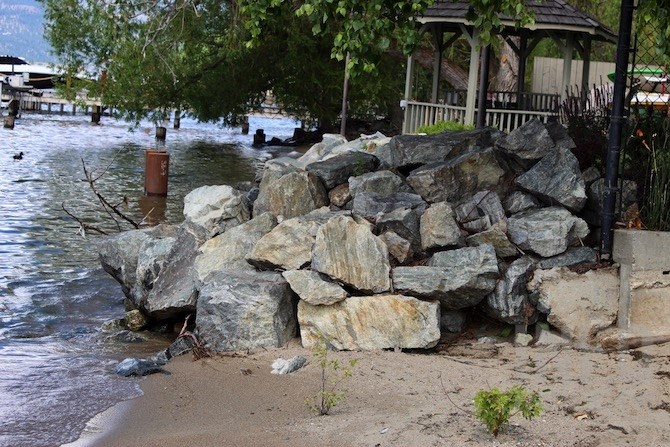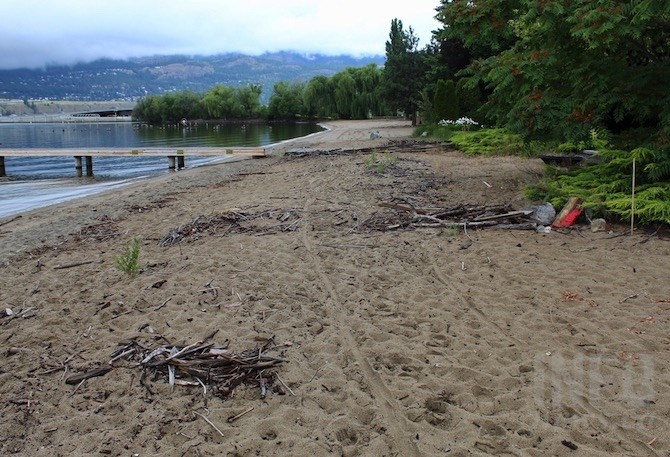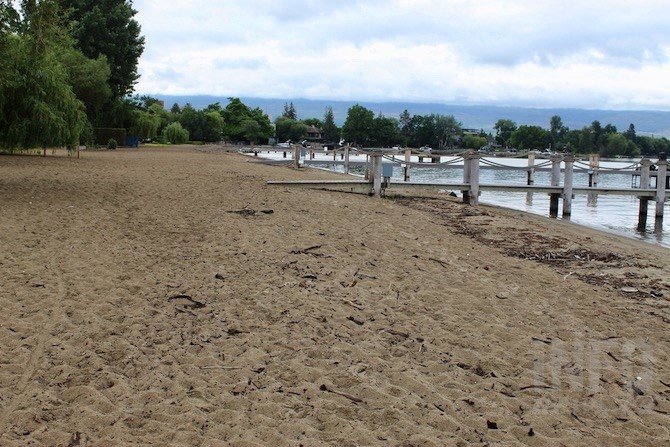
Despite efforts to remove barriers to public access to Kelowna's lakeshore, barricades persist. This pile of rocks is on the north side of Rotary Beach.
(ROB MUNRO / iNFOnews.ca)
July 05, 2019 - 7:30 PM
KELOWNA - After two summers of letting people know they have the right to access Kelowna’s waterfront, the Walk the Beach campaign will not continue for a third year.
“I think we got the message out as clearly and as effectively as we could that a lot of people in Kelowna would like more public accessibility to the lakefront,” Al Janusas, one of the key organizers told iNFOnews.ca.
“But neither the province nor the city has taken any concrete steps toward achieving that.”
People have the right to walk along Okanagan Lake below the high water mark but are prevented from doing so in many places by fences, docks, walls and rocks.
“There is virtually no enforcement of laws on the waterfront,” Janusas said. “Over the years, in Kelowna, they got used to doing whatever they wanted in erecting all kinds of fences and walls and blockades to stop people from walking on the foreshore, which legally they’re allowed to do.”
Realtor Brenda Bachmann had joined Janusas in the campaign to publicize the intrusions into the lake.
“There will not be a 2019 Walk the Beach,” Bachmann said in an email.
“My main goal for starting the event was to bring awareness to this problem and to residents and visitors that they can legally walk the foreshore. I believe we have done that.
“The fact is that the city washes their hands of the issue, claiming it is up to the province when they (the city) could handle (it) within bylaws and permits. And the province does nothing. So, nothing gets done. More blockades, fences, walls, rip-rap, docks without required stairs are going up every year. And no one is willing to do anything.”
The provincial government has jurisdiction over the land below the high watermark. In an email, staff at the Ministry of Forest, Lands and Natural Resources said about 1,200 docks were damaged or destroyed in 2017 and 2018 and about 600 permits were issued to rebuild or repair those docks.
But the ministry also stated: “We do not conduct audits to ensure docks are constructed to approved standards.”
Janusas said after putting in a huge amount of time and effort to get the province to enforce its rules, a couple of property owners were ordered to make changes.
The rules are the responsibility of natural resource officers to enforce and, Janusas said, they have many other things to deal with, particularly wildlife issues.
The city only enforces rules on activities above the high watermark.
"Docks should never extend beyond the high water mark,” Dean Strachan, the city’s suburban and rural planning manager, said. “If they do, they need an environmental development permit.
“There has been a lot of discussion through the media in recent years around pedestrian access along the lakeshore below the high water mark and obstructions that occur. When we identify them as a city, we pass the information on to the province."
What neither Janusas or Bachmann want to talk about is a lawsuit that was filed against them in 2017 after the first Walk the Beach event.
Court documents from that case show that one of the people on the walk, Helen Schiele, tripped while crossing a row of rocks piled along the beach near the property line of Geby Wager’s McDougal Street home, just south of the Bennett Bridge.
She sued him. Than Wager countersued, Janusas, Bachmann, the City of Kelowna and province
In the end, after almost a year, an out of court settlement was reached where all claims were dropped.
Those rows of rocks are no longer on the beach but there are piles of sticks at about the same location – the only such debris on that stretch of the beach.
Janusas didn’t want to talk about the lawsuit.
“I don’t want to open that can of worms,” he said.
Janusas has a website, Plan Kelowna, where he shows some of the blockages but also has maps of four walks along more accessible parts of the lake.
Anyone with a complaint about docks or other obstructions along the lake can file them with the province on line.
— This story was corrected on July 16, 201,9 to say that Helen Schiele only sued Geby Wager.

Two years ago rows of large rocks blocked public access in front of these McDougal Street homes. A Walk the Beach participant tripped and lawsuits were filed. This is the only stretch of that beach where there is any debris.
(ROB MUNRO / iNFOnews.ca)

Looking south of the above photo, this is an example of good public access to Okanagan Lake below the high water mark.
(ROB MUNRO / iNFOnews.ca)
To contact a reporter for this story, email Rob Munro or call 250-808-0143 or email the editor. You can also submit photos, videos or news tips to the newsroom and be entered to win a monthly prize draw.
We welcome your comments and opinions on our stories but play nice. We won't censor or delete comments unless they contain off-topic statements or links, unnecessary vulgarity, false facts, spam or obviously fake profiles. If you have any concerns about what you see in comments, email the editor in the link above.
News from © iNFOnews, 2019